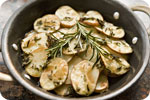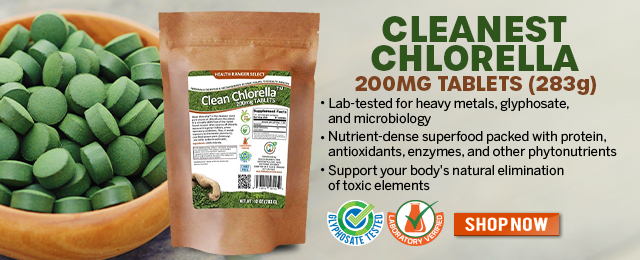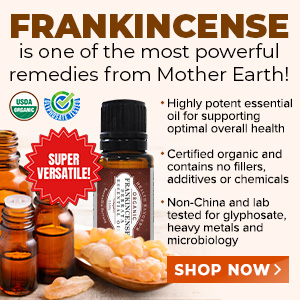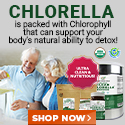
- Warp Speed 2.0: Trump Administration ACCELERATES Gates-funded, self-amplifying bird flu vaccines
- DMSO and Natural Dyes: A suppressed cancer treatment resurfaces in independent research
- Chemical cocktails in processed foods linked to diabetes, validating natural health warnings
- Transhuman vectors of disease: Young adults continue to produce spike proteins ONE YEAR after receiving COVID vaccine
- Study finds bananas more effective than salt reduction for lowering blood pressure
- Prominent doctors call for new holistic therapies to address CANCER SPIKE: Tree barks provide anti-cancer treatment options
- 8 U.S. states may EXPAND vaccine exemptions in 2025, and parents have many reasons to STOP THE SHOTS
- Fermented foods like sauerkraut may outshine modern medicine in gut health, research finds
- STAGING BEFORE RELEASE: WHO Runs 2-Day Pandemic Simulation 'Exercise Polaris'
- Ancient mummies rewrite human history with “ghost” lineage discovery
- Aerosolized bioweapons? Strange “diploid biomasses” falling out of the sky in Florida captured under the microscope
- Surge in KIDNEY FAILURES linked to common medications
- Millions of gun owners could be challenged in court and lose their firearms if DOJ doesn’t step in to stop crazy ATF rule
- Mike Adams releases country western hit single: Goin’ Back in Time is Comin’ Home
- Analysis: The coming economic collapse, a mass uprising and Trump's three secret weapons to halt the growing revolt
- Widespread social and economic unrest: Steve Quayle issues urgent financial warning of imminent asset collapse in new interview with Mike Adams
- Israeli lobbyists boast of controlling US national security policy in leaked AIPAC audio
- U.S. lawmakers investigate Meta over alleged China collaboration
- Israeli lobbyists boast of controlling US national security policy in leaked AIPAC audio
- Aerosolized bioweapons? Strange “diploid biomasses” falling out of the sky in Florida captured under the microscope
- Analysis: The coming economic collapse, a mass uprising and Trump's three secret weapons to halt the growing revolt
- Fauci is back in the limelight, and he’s busy promoting a future COVID or FLU pandemic
- Widespread social and economic unrest: Steve Quayle issues urgent financial warning of imminent asset collapse in new interview with Mike Adams
- Kiss Your Genetic Privacy Good-Bye! 23andMe Gets Green Light to Sell Your Intimate Genetic Details to Anyone They Want
- Mike Adams releases country western hit single: Goin’ Back in Time is Comin’ Home
- U.S. lawmakers investigate Meta over alleged China collaboration
- Tulsi Gabbard leads charge against the Biden regime’s global censorship of the 'Disinformation Dozen'
- Pfizer's RSV vaccine linked to preterm births as drug giant CONCEALED RISKS from pregnant women in unethical clinical trials
- Dane Wigington exposes climate engineering as ‘All-Out Weather and Biological Warfare’
- Shedding light on the dark side of MMR vaccines: How vaccinated individuals SPREAD MEASLES & put the vulnerable at risk
- TAKE IT DOWN Act advances in Congress amid free speech concerns
- CLOT SHOT PLANDEMIC UNFOLDING: Fibrous, rubbery clots caused by covid injections have prion-like seeding activity
- Chemtrails unveiled: How the CIA and Big Business are manipulating the weather for profit
- Curcumin’s ancient healing power supercharges muscle recovery, and its effects are compounded with anti-inflammatory foods and supplements
- Criminal referral requests filed against Fauci and top COVID officials in seven states
- Defunding DEADLY mRNA jabs: Government funding for mRNA technology being scrutinized and sidelined until proven "safe and effective" for real
- Newly released JFK files reveal Pentagon's role in creating Lyme disease and covid in the same lab
- Analysis: The coming economic collapse, a mass uprising and Trump's three secret weapons to halt the growing revolt
- Mike Adams releases country western hit single: Goin’ Back in Time is Comin’ Home
- Aerosolized bioweapons? Strange “diploid biomasses” falling out of the sky in Florida captured under the microscope
- Kiss Your Genetic Privacy Good-Bye! 23andMe Gets Green Light to Sell Your Intimate Genetic Details to Anyone They Want
- European Court of Justice: Healthcare professionals who promoted or administered COVID-19 vaccines are CRIMINALLY LIABLE for any harm caused
- Federal employees whine over DOGE's new directive requiring them to do a 5-point summary of weekly accomplishments
- Widespread social and economic unrest: Steve Quayle issues urgent financial warning of imminent asset collapse in new interview with Mike Adams
- U.S. approves new Russian ambassador as diplomatic thaw continues
- Government waste exposed: Hegseth supports Musk’s demand for accountability from federal workers
- Now you can HEAR chemistry: Health Ranger translates molecules into music in stunning video demonstration that will blow your mind (and your ears)
- Fauci is back in the limelight, and he’s busy promoting a future COVID or FLU pandemic
- CLOT SHOT PLANDEMIC UNFOLDING: Fibrous, rubbery clots caused by covid injections have prion-like seeding activity
- I Want My Bailout Money – new song released by Mike Adams
- I Want My Bailout Money – new song and music video released by Mike Adams
- Tulsi Gabbard leads charge against the Biden regime’s global censorship of the 'Disinformation Dozen'
- Trump administration poised to overhaul crypto regulations with new SEC leadership
- The Health Ranger releases “Vaccine Zombie” song and music video, using AI-animated zombies for the music video
- Red Cross issues warning to stop blood plasma donations from vaccinated people
- Scientists confirm: GENIUS brain function can be spontaneously unleashed in humans without any apparent cause
- EPA advisor admits the agency is funneling billions to climate groups ahead of Trump’s return to White House
- HYSSOP: What research reveals about the health benefits of this ancient holy herb
- Two containers with completed ballots fall out of truck in Florida
- Newly released JFK files reveal Pentagon's role in creating Lyme disease and covid in the same lab
- Global leaders unite to clamp down on “misinformation” with UN-backed Cascais Declaration
- Mike Adams releases country western hit single: Goin’ Back in Time is Comin’ Home
- BREAKING: 2025 NDAA authorizes mandatory military draft of WOMEN across America… as Pentagon pursues global NUCLEAR war with both Russia and China at the same time
- Michael Yon warns of a ZIONIST TAKEOVER in Trump’s second administration
- The Health Ranger releases “Vaccine Zombie” song and music video, using AI-animated zombies for the music video
- Ozempic and Wegovy weight loss drugs are injectable LIZARD VENOM PEPTIDES that may unleash a devastating wave of organ failure… side effects align with symptoms of SNAKE BITES
- BOMBSHELL: DNA testing kits are a SCAM to develop ethnic-specific bioweapons
- Israeli soldiers accused of even more torture and abuse in the West Bank
- I Want My Bailout Money – new song released by Mike Adams
- These 13 countries just signed an agreement to engineer a global FAMINE by destroying food supply
- NASA admits that climate change occurs because of changes in Earth’s solar orbit, and NOT because of SUVs and fossil fuels
- RFK Jr. clears key hurdle: Sen. Susan Collins backs controversial HHS nominee, signaling a new era for health policy
"Acrylamide is formed during the preparation of many ordinary foods. It is therefore important both for consumers and the food industry to find methods to reduce the acrylamide content," says Kit Granby, senior scientist at the National Food Institute, Technical University of Denmark.
Over the past five years, a research project has identified several ways of reducing acrylamide in foods. The project is a collaboration between the National Food Institute and the Department of Systems Biology at the Technical University of Denmark, the Faculty of Life Sciences at the University of Copenhagen and five Danish food companies.
Tests With Processing Conditions
Acrylamide is a chemical formed when frying, baking or grilling carbohydrate-rich foods at temperatures above 120°C. Acrylamide is thus found in a number of foods, such as bread, crisps, French fries and biscuits.
In addition to the heating temperature, tests carried out during the project also show that factors such as time of processing, pH, water content, water activity and the content of the amino acid asparagine and sugar in the raw ingredients influence the formation of acrylamide. For example, the longer the cooking time and the lower the water content, the higher the acrylamide content in the heat-processed food.
"By changing and optimising these factors when producing foods, the acrylamide content of many different types of products can be reduced considerably," says Kit Granby
Tests With Antioxidants
The collaborative project also included a PhD research project which tested the addition of different antioxidants.
The addition of rosemary to dough prior to baking a portion of wheat buns at 225°C reduced the acrylamide content by up to 60 per cent. Even rosemary in small quantities – in one per cent of the dough – was enough to reduce the acrylamide content significantly.
Flavonoids are another type of antioxidant found, among other things, in vegetables, chocolate and tea. Tests also showed that the addition of the flavonoids epicatechin and epigallocatechin from green tea considerably reduced the acrylamide content.
"Antioxidants are substances which inhibit the formation of free radicals in the food and eliminate free radicals in the body. Our tests indicate that free radicals are formed when cooking and potentially increasing the acrylamide content in certain foods," explains Rikke Vingborg Hedegaard, PhD at the National Food Institute, Technical University of Denmark, who is responsible for the PhD project.
"However, the findings do not show a general association between antioxidants and reducing acrylamide in foods. The tests indicate that different antioxidants do not have the same effect on the formation of acrylamide, and that it is important how antioxidants are added to a product to have an effect on the acrylamide content," adds Rikke Vingborg Hedegaard.
The above findings are just some of the results obtained by the research collaboration project. Other tests show that blanching, salt and the enzyme asparaginase may reduce the acrylamide content in potato products.
The findings have been published in a number of scientific journals, most recently in the journals European Food Research and Technology, Food Chemistry, the Journal of Agricultural and Food Chemistry and the Journal of Food Engineering.
From my perspective, it is only good sense to also supplement with antioxidants. Research has now shown the many powerful benefits of Vitamin D, with up to 5000 IU now considered a safe daily dose. Recently, research has also shown the antioxidant Vitamin E to actually slow down the decline of aging. At a minimum I would take both Vitamin D and Vitamin E daily.
Source:
AlphaGalileo (http://www.alphagalileo.org/)
Technical University of Denmark (2008, March 4). A Little Rosemary Can Go A Long Way In Reducing Acrylamide In Food. (http://www.dtu.dk/english.aspx)
About the author
Leslee Dru Browning is a 6th generation Medical Herbalist & Nutritionist from the ancestral line of Patty Bartlett Sessions; Pioneer Mid-Wife & Herbalist. Leslee practiced Medical Herbalism and Nutritional Healing for over 25 years and specialized in Cancer Wellness along with Chronic Illness. She now devotes her career to teaching people, through her writing, about Natural Healing from An Herbal Perspective.4665 at FETCH.news
Get independent news alerts on natural cures, food lab tests, cannabis medicine, science, robotics, drones, privacy and more.
Take Action: Support Natural News by linking to this article from your website
Permalink to this article:
Embed article link: (copy HTML code below):
Reprinting this article:
Non-commercial use OK, cite NaturalNews.com with clickable link.
Follow Natural News on Facebook, Twitter, Google Plus, and Pinterest
Science News & Studies
Medicine News and Information
Food News & Studies
Health News & Studies
Herbs News & Information
Pollution News & Studies
Cancer News & Studies
Climate News & Studies
Survival News & Information
Gear News & Information
News covering technology, stocks, hackers, and more



"Big Tech and mainstream media are constantly trying to silence the independent voices that dare to bring you the truth about toxic food ingredients, dangerous medications and the failed, fraudulent science of the profit-driven medical establishment.
Email is one of the best ways to make sure you stay informed, without the censorship of the tech giants (Google, Apple, Facebook, Twitter, YouTube, etc.). Stay informed and you'll even likely learn information that may help save your own life."
–The Health Ranger, Mike Adams












































